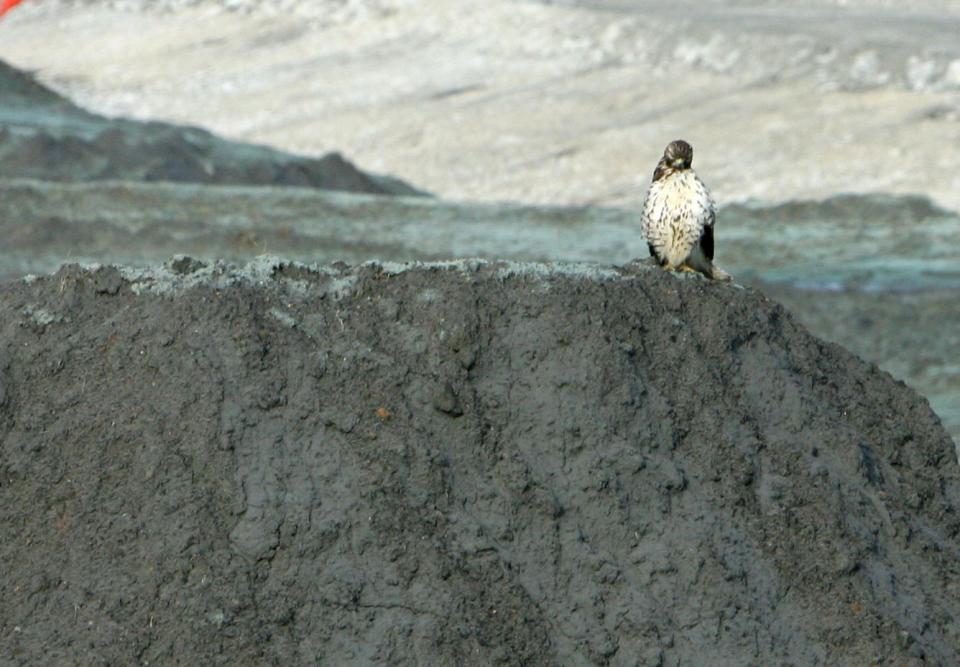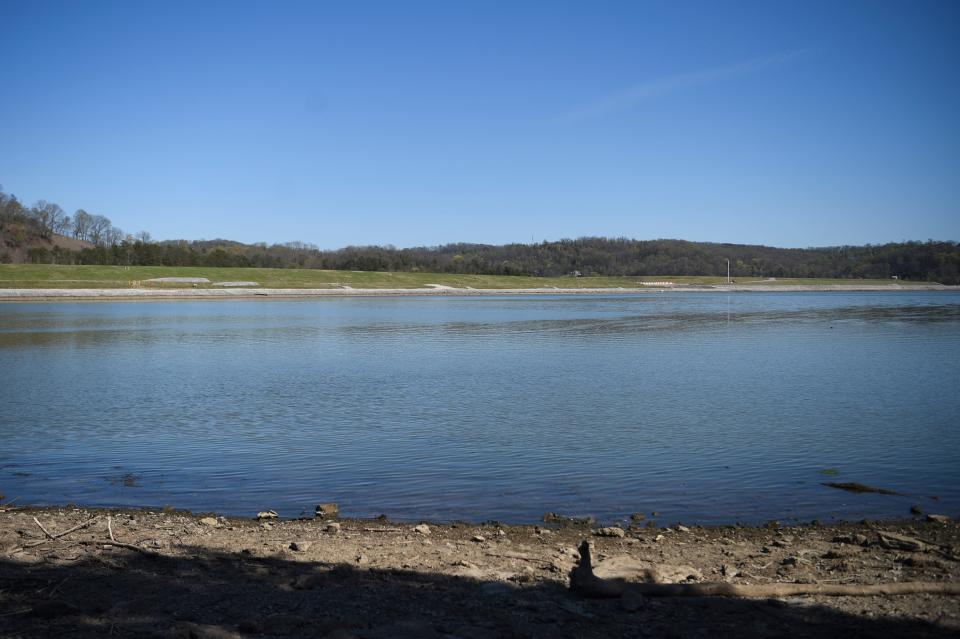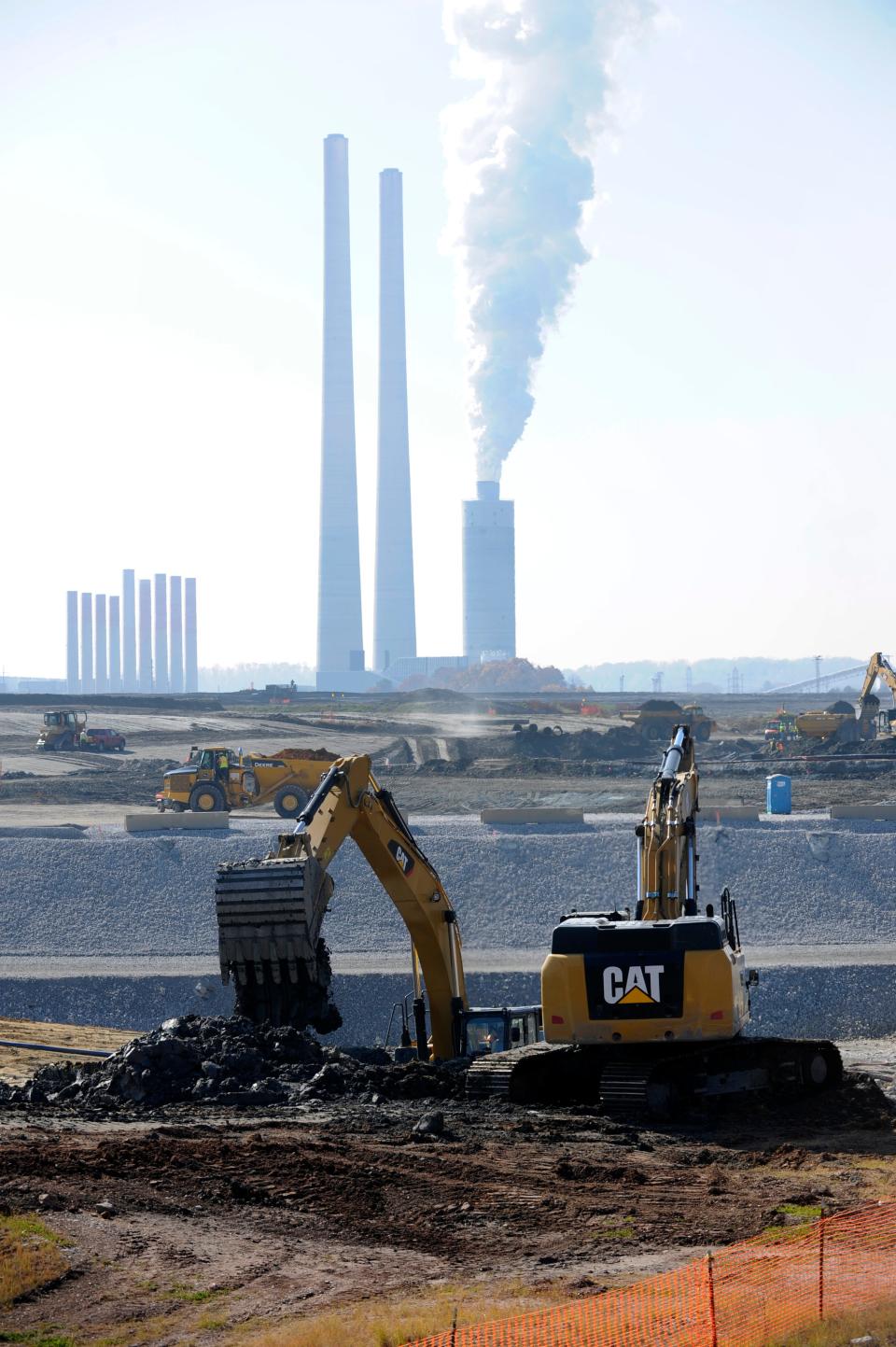What is coal ash? Can it harm your health if you're exposed? Experts weigh in
When the sun sets on the Tennessee Valley Authority’s use of coal power plants, it won’t set on the utility’s responsibility for the forever waste of coal ash, the product of decades of burning coal.
TVA has burned coal since at least 1933, starting with the Wilson Steam Plant in Muscle Shoals, Alabama. Over the years, TVA has had about 13 coal plants spread across its seven-state region, five of which haven’t been retired yet.
This has resulted in tons of coal ash, which is exactly what it sounds like: the ash left over from the process of burning coal. Coal ash can pose varying degrees of health impacts depending on what elements are in the ash, how large the ash particles are, how a person has been exposed and for how long.

What is coal ash?
Coal is primarily composed of carbon. When the carbon is burned away, what’s left is a concentrated waste of elements and particles, said Laura Ruhl, a former assistant professor of environmental geochemistry and hydrology at the University of Arkansas, Little Rock.
No coal ash is the same. The composition varies depending on where the coal was mined and how it was processed, burned and disposed of.
Generally speaking, coal ash could be composed of just about any naturally occurring element on the periodic table, said Grace Schwartz, an assistant professor of chemistry at Wofford College.
Some of the more concerning elements in coal ash can include heavy metals such as mercury, lead, arsenic, cadmium or chromium. Coal ash also can contain elements that emit radiation.
With so many possible elements in the ash, assessing health risks and creating regulations can be hard, public health expert Greg Nichols said.
Cover it? Move it? What experts suggest could address coal ash at Claxton playground
What are some different types of coal ash?
Coal ash is a broad term for coal waste, and there are multiple subcategories. Here are a few types of coal ash, according to the Environmental Protection Agency:
Fly ash: This powdery ash is created when “finely ground coal” is burned in a boiler. It’s primarily composed of silica.
Bottom ash: These are sand- and gravel-size particles, according to the U.S. Department of Transportation. These particles form at the bottom of a coal furnace, according to the EPA.
Boiler slag: This is a type of molten bottom ash that becomes pellets with “a smooth glassy appearance” once cooled in water. This forms in specific types of furnaces.
Flue gas desulfurization material: This material can be wet or dry and contain calcium sulfite or calcium sulfate in a wet sludge or be in the form of a mixed powder with sulfites and sulfates.
What health risks from coal ash are known?
While coal ash is still being studied to measure potential risks, some of the health effects from properties such as the size of its particles or the elements in it are known.
Small particles, known as particulate matter, can be inhaled or ingested, bringing them into the body. Small enough particles can be brought into the bloodstream and lungs, according to the EPA.
That means "that a lot of the metals that were in the gaseous phase are now absorbing to the surface of these ash particles, and the smaller ash particles, the greater the amount of metals and things of concern on the surface of them,” Ruhl said.

Ruhl said that once those particles are deposited into the body, the body will have its own reactions to the metals and, potentially, elements that emit radiation.
Paul Terry, a professor of epidemiology at the University of Tennessee’s Department of Medicine, said that when elements meet liquids in the body such as lung fluid or stomach acid, those liquids can cause those elements and metals to dissolve, which means the elements could be absorbed into the bloodstream and have a variety of impacts on the body.
Some heavy metals such as mercury and arsenic have been studied individually for health impacts, said Neha Pathak, a founding member of the Georgia Clinicians for Climate Action.
“Selenium is ... one that's really interesting because (at) low concentrations, it's actually considered a nutrient, like, our bodies need small amounts of selenium,” said Amrika Deonarine, assistant professor of environmental engineering at Texas Tech University. “Then once that concentration gets too high, once we're exposed to too much of it, and it can have negative effects.”
It’s difficult to measure the total impacts of exposure to coal ash because the composition varies.
Type of exposure to coal ash can influence health impacts
Exposure to coal ash involves multiple elements at once, which could have a greater impact.
“It's different when you put them together. The tolerance we have for these chemicals goes down when they're delivered together,” Terry said. “Models or estimates that just look at individual components fail to understand and quantify the synergy that can cause much more damage than any one of those things could alone at much lower concentrations.”
Terry said that vulnerable populations - such as asthmatics, children and people with histories of cancer and heart disease - are more at risk of having negative reactions when exposed to contaminants.
We know there can be health impacts from being exposed to coal ash over a long periods of time, Pathak said, but not at what dose those impacts might appear.
For subscribers: Why the children of Claxton, Tennessee, have a playground built on top of coal ash
“How long does it take and how many hits do you need to have in order for it to cause this long-term damage?" Pathak said. "Regionally, people are being exposed to different things. So what is that chemical brew that is really dangerous versus somewhat dangerous versus maybe your body can handle it? We don't know all of these things."
The risks also can vary depending on how a person was exposed. If a person works in a place where they are exposed to coal ash daily without a mask or respirator, they could be exposed to higher levels of the ash than a person who is exposed in a single instance. The former type of exposure is embodied by the cases brought by workers who cleaned up TVA’s 2008 Kingston coal ash spill.
Their lawsuits yielded a verdict in 2018 that linked the worker’s working conditions and exposure to the ash at the spill site to about 10 different health conditions and diseases suffered by the workers years later, including lung cancer, heart and respiratory conditions, types of cancer and peripheral neuropathy.
Terry and Pathak both pointed out that there could be health impacts to communities that live near coal plants or ash disposal sites where the ash could be getting into groundwater, nearby rivers and creeks, air or soil. This type of low-level exposure over a long period of time has not been studied enough to know exactly what the total impact could be.
“Don't underestimate in any way potential harm when it comes to communities. Of course, chronic exposure is horrible, acute exposure is horrible. Chronic low level exposures? Probably not good at all,” Terry said.
How does TVA dispose of coal ash?
Because ash particles are hard to control when dry, some utilities opt for storing their ash in ponds or impoundments. That used to be TVA’s method of disposal before the Kingston coal ash spill, when a dike holding back a fly ash disposal pond broke, releasing 5.4 million cubic yards of wet ash that covered homes and contaminated the Emory River Channel.
After Kingston, TVA started storing its ash dry with a technology-based monitoring system that oversees the disposal sites 24/7. To contain the ash and prevent it from becoming airborne and coming in contact with people, TVA also has “fugitive dust” plans that can include watering down the ash and compacting it.
“We use compaction technology and cutting-edge 3D technology to map each layer of coal ash that is placed into TVA’s dry storage landfills to further ensure the safety and stability of our sites,” TVA’s page about coal ash says.
While the dust plan should combat potential releases of ash into the air, coal ash also can enter the environment by leaking into groundwater underneath the disposal sites.
“So different elements have different behaviors, and some of them will dissolve easily into water, for example, because of their chemical form, and other environmental factors like pH and redox potential which is basically related (to) how much oxygen there is,” Deonarine said.
For communities and individuals primarily using well water for drinking, this can pose a direct health risk if ash is leaking into nearby groundwater.
In an effort to monitor potential releases of coal ash into groundwater, TVA has monitoring wells at each of its disposal sites and plants.
In Tennessee, this data can be used to inform the Tennessee Department of Environment and Conservation of whether the ash at TVA’s plants and disposal sites poses a certain level of risk to the environment and the people living nearby.

After Kingston, TDEC released an order requiring an investigation of all coal ash TVA has disposed of in Tennessee. The investigation could mean TVA might need to remediate its disposal sites by digging up and moving the ash it has already disposed of to another location.
Is coal ash considered hazardous waste?
The EPA does not consider coal ash as “hazardous waste,” a label that would come with specific restrictions on how the waste would have to be handled and disposed of.
“So just like (the) pure volume of this material (coal ash) that's out there is enormous,” Ruhl said. “And I think that was one of the factors that went into considering whether this should be a hazardous waste or not, was the fact that there's so much of this stuff that if it was deemed a hazardous waste, and they had to dispose of it in a hazardous waste landfill, it would fill them … up very quickly.”
Instead, coal ash is still regulated federally but under “minimum federal criteria for the operation of municipal waste and industrial waste landfills,” according to the EPA. The restrictions include design of the landfill, location, clean up, financial assurance, corrective action and closure requirements.
In 2015, the EPA created the first national regulations for coal ash with the Coal Combustion Residuals Rule as a result of the 2008 Kingston coal ash spill.
The rule focuses on the risks of disposing of coal ash, such as contaminants leaking into groundwater, particles becoming airborne and the potential breaking of impoundments that hold wet coal ash.
“Additionally, the rule sets out recordkeeping and reporting requirements as well as the requirement for each facility to establish and post specific information to a publicly-accessible website,” the EPA says on its page about the rule.
In addition to the baseline created by the federal government that all states must abide by, individual states can create their own regulations that could be more restrictive than the federal rule. In Tennessee, TDEC’s commissioner’s order currently goes beyond the scope of what the federal coal ash rule requires, according to a press release about the order.
TDEC can order additional investigations, remedial actions, maintenance and monitoring.
Do the regulations account for all coal ash everywhere?
Not necessarily. Coal was burned for decades around the country and coal ash was generated for just as long. The regulations that exist today for coal ash disposal and usage didn’t always exist.
This means there’s a very real possibility we don’t know where all of the coal ash is in the country and therefore have no evaluation of how safe it is in some current locations.
More: Coal ash could be reused anywhere. Here's how government does - and doesn't - regulate it
This article originally appeared on Knoxville News Sentinel: What is coal ash? How is coal ash disposed of? Here's what experts say

